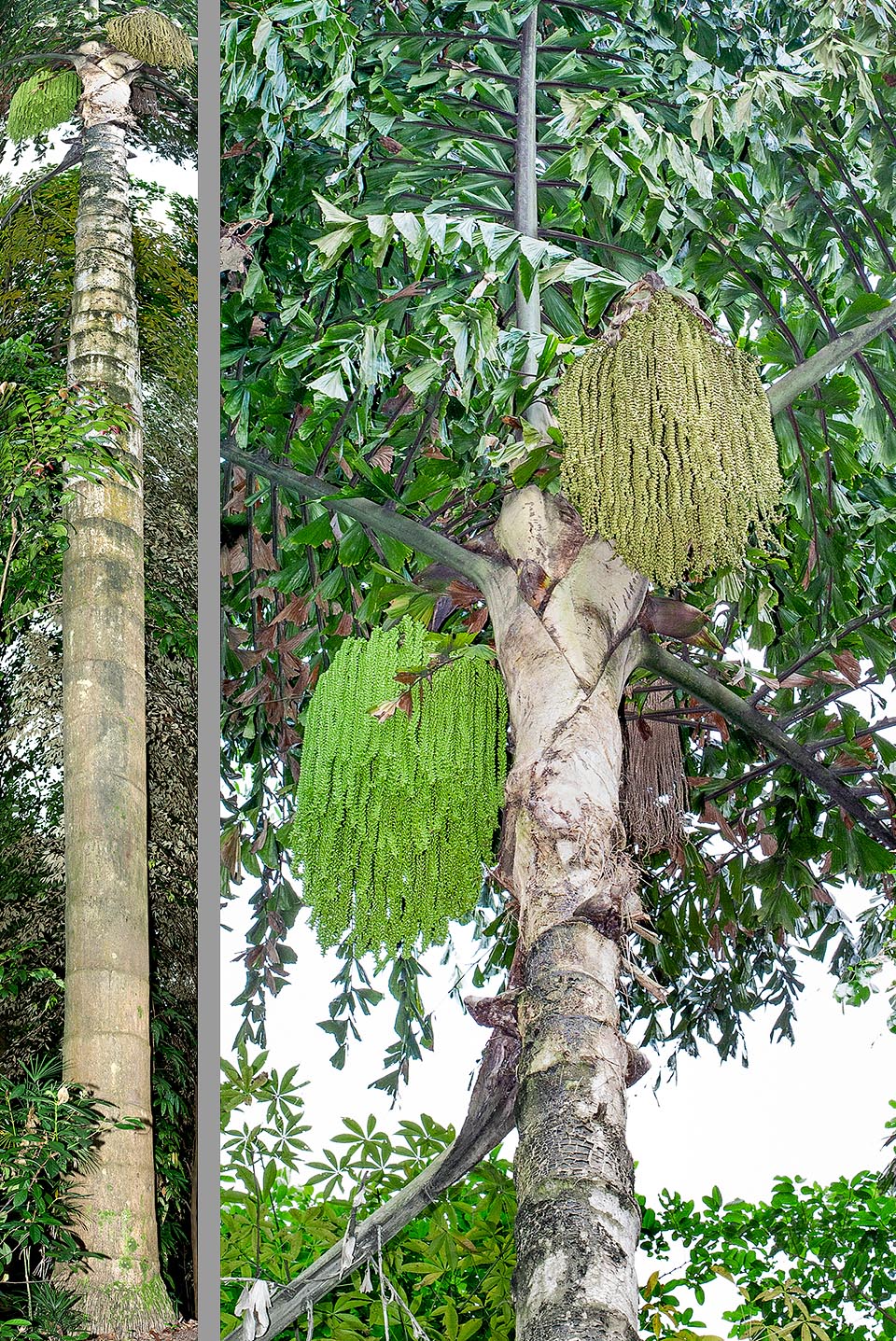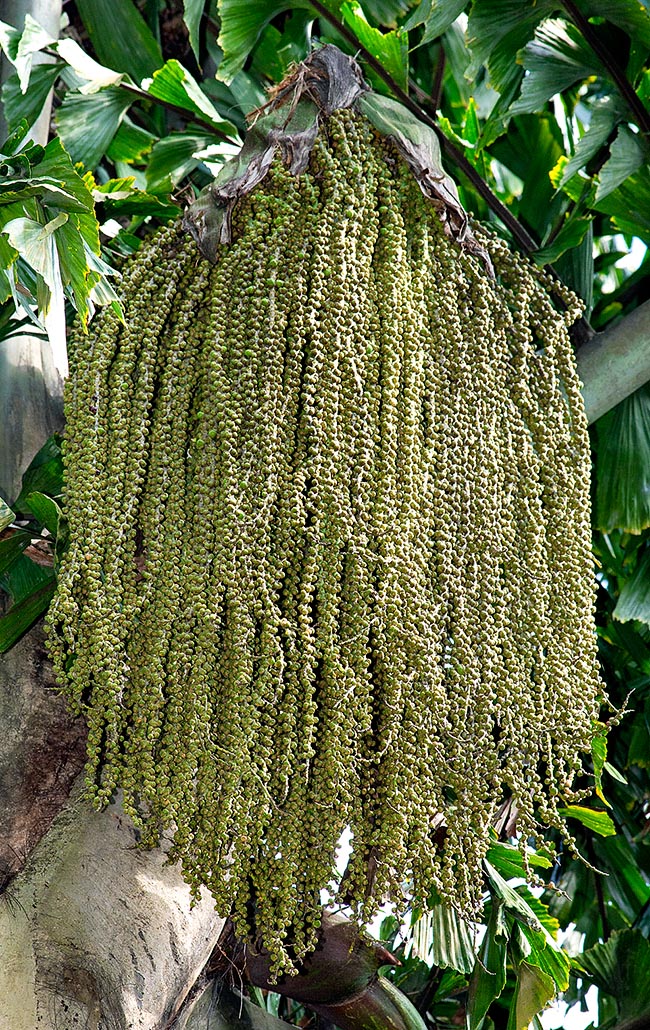Family : Arecaceae

Text © Alessandro Marini

English translation by Mario Beltramini

Caryota no is a monoecious species, endemic to Borneo, native to the humid mountain forests. This palm tree can easily exceed 20 m of height with an 80 cm broad stem and completes its vital cycle in about 15 years. The fructification process lasts 2-3 years and the plant dies when the fruits of the last inflorescence below ripe © G. Mazza
Caryota no Becc. is a monoecious palm endemic to the island of Borneo and is present in the humid mountain forests. It is monocarpic and completes its vital cycle in about 15 years, dying after the blooming and the fructification.
The name of the genus Caryota comes from the Greek “karyótis”, utilized by Dioscorides to define the date, fruit of the palm. The name of the species no, comes from the epithet given to the plant in Malay language “cajù nó”.
The stem is solitary, erect, grey-brown, stocky and very tall. In fact, it may exceed the 20 m with a diametre of up to 80 cm. The stem is marked by rings in relief, scars of the fallen foliar bases. At the base of the stem can get out aerial roots that contribute to the stability of the plant. The stem is very spongy, but very hard, very difficult to remove once the palm has concluded its vital cycle.
The petioles are up to 1 m long, thick and hard, green-grey, covered by dark scales and display black fibers at the base. The petiole continues on a sheath wrapping the stem, also thick and hard, almost woody, of grey-brown colour. The foliar crown is large, as it can exceed 10 m. The leaves are bipinnate, up to 5 m long and up to 3 m broad, and have a triangular shape, wide at the base and narrow towards the apex.

The fruits, initially green then yellow, finally black or purple when ripe, contain one or two seeds of about 20 cm of diametre. The endosperm is very toxic as rich of calcium oxalate and it’s good not to touch it © Giuseppe Mazza
The primary pinnae are about 20 per side of the rachis, opposite, up to 1,5 m long, drooping in the apical part. The secondary pinnae are up to 30 cm long and 15 cm broad, and display coriaceous triangular leaflets, of pale green colour, with torn edges, similar to the caudal fins of the fishes, hence the name “Borneo fishtail palm”, or “Giant fishtail palm”.
The inflorescences emerge from the foliar bases, starting progressively from the higher leaves up to the lower ones and in the same time the development of the plant slows down until the stoppage. The inflorescences are sustained often by a woody peduncle and are very ramified, presenting up to 180 drooping branches, up to 2 m long.
The flowers are yellow, arranged in triads formed by one female and two males.
Initially the fruits are green, then yellow and finally black or purple when ripe, roundish, up to 2,5 cm broad, and contain one or two dark brown seeds, glossy, round, with a diametre of about 2 cm.
The process of fruitification lasts 2 to 3 years and the plant passes away when the fruits of the last inflorescence below are ripe.
The endosperm of the fruits is toxic, because they contain calcium oxalate so it is necessary a lot of attention in touching them. Several studies are under way to verify the antioxidant action of the extract of Caryota no seeds.
The look of Caryota no is very similar to that of Caryota obtusa, native to China, India, Laos and Thailand, but rather different from the other species of the group, like Caryota urens. In Caryota no as well as in Caryota obtusa the trunk is massive and the leaf is impressive, wide and flat, but the dimensions of Caryota obtusa are bigger than those of Caryota no, in all its parts.
This quite beautiful species is very cultivated in the warm subtropical belt, but is very sensitive to the decrease of temperature and does not survive in zones where even slight frosts occur. Actually, it is the most sensitive to cold species among the other big Caryota and in the Mediterranean with lowest temperatures dropping down under 5 °C, it tends to slow down the growth or even to languish.
Seeing its size, it is not a species cultivable in small gardens, also for the issue related to the removal of the leaves, once dry and of the dead plants. Caryota no prefers the humid soils, rich in humus, well drained. The young specimens prefer the shady positions, whilst the adult ones prefer the exposition to the direct sun. It does not stand strong winds that can easily fall down the big plants. It is necessary to keep in mind this aspect when planning to plant them in zones particularly exposed to the winds.
The local populations of Borneo eat the marrow of the vegetative apex, the so-called “heart of palm”. The petioles are utilized to fabricate fishing lines and the fibers are intertwined in baskets. The extremely hard wood is used when constructing houses.
The species is classified as “Last Concern”, species with minimal risk by the IUCN (International Union for Conservation of Nature).
Synonyms: Caryota rumphiana var. borneensis Becc.
